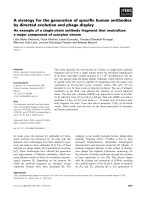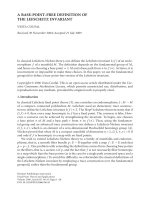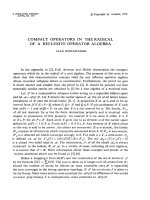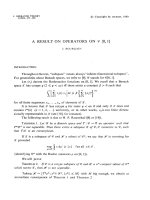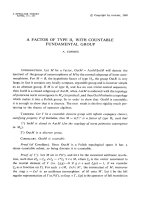Báo cáo toán học: "A Pfaffian–Hafnian Analogue of Borchardt’s Identity" ppt
Bạn đang xem bản rút gọn của tài liệu. Xem và tải ngay bản đầy đủ của tài liệu tại đây (91.22 KB, 8 trang )
A Pfaffian–Hafnian Analogue of Borchardt’s
Identity
Masao ISHIKAWA
Faculty of Education, Tottori University
Koyama, Tottori, Japan
Hiroyuki KAWAMUKO
Faculty of Education, Mie University
Tsu, Mie, Japan
Soichi OKADA
Graduate School of Mathematics, Nagoya University
Chikusa-ku, Nagoya, Japan
Submitted: Sep 13, 2004; Accepted: Jun 6, 2005 ; Published: Jun 14, 2005
Mathematics Subject Classifications: 05E05
Abstract
We prove
Pf
x
i
− x
j
(x
i
+ x
j
)
2
1≤i,j≤2n
=
1≤i<j≤2n
x
i
− x
j
x
i
+ x
j
· Hf
1
x
i
+ x
j
1≤i,j≤2n
(and its variants) by using complex analysis. This identity can be regarded as
a Pfaffian–Hafnian analogue of Borchardt’s identity and as a generalization
of Schur’s identity.
1 Intro duction
Determinant and Pfaffian identities play a key role in combinatorics and the repre-
sentation theory (see, for example, [4], [5], [6], [8], [10], [11]). Among such determi-
nant identities, the central ones are Cauchy’s determinant identities ([2])
det
1
x
i
+ y
j
1≤i,j≤n
=
1≤i<j≤n
(x
j
− x
i
)(y
j
− y
i
)
n
i,j=1
(x
i
+ y
j
)
, (1)
det
1
1 − x
i
y
j
1≤i,j≤n
=
1≤i<j≤n
(x
j
− x
i
)(y
j
− y
i
)
n
i,j=1
(1 − x
i
y
j
)
. (2)
the electronic journal of combinatorics 12 (2005), #N9 1
C. W. Borchardt [1] gave a generalization of Cauchy’s identities:
det
1
(x
i
+ y
j
)
2
1≤i,j≤n
=
1≤i<j≤n
(x
j
− x
i
)(y
j
− y
i
)
n
i,j=1
(x
i
+ y
j
)
· perm
1
x
i
+ y
j
1≤i,j≤n
,
(3)
det
1
(1 − x
i
y
j
)
2
1≤i,j≤n
=
1≤i<j≤n
(x
j
− x
i
)(y
j
− y
i
)
n
i,j=1
(1 − x
i
y
j
)
· perm
1
1 − x
i
y
j
1≤i,j≤n
.
(4)
Here perm A is the permanent of a square matrix A defined by
perm A =
σ∈S
n
a
1σ(1)
a
2σ(2)
···a
nσ(n)
.
This identity (3) is used when we evaluate the determinants appearing in the 0-
enumeration of alternating sign matrices (see [11]).
I. Schur [12] gave a Pfaffian analogue of Cauchy’s identity (1) in his study of
projective representations of the symmetric groups. Schur’s Pfaffian identity and its
variant ([9], [14]) are
Pf
x
j
− x
i
x
j
+ x
i
1≤i,j≤2n
=
1≤i<j≤2n
x
j
− x
i
x
j
+ x
i
, (5)
Pf
x
j
− x
i
1 − x
i
x
j
1≤i,j≤2n
=
1≤i<j≤2n
x
j
− x
i
1 − x
i
x
j
. (6)
In this note, we give identities which can be regarded as Pfaffian analogues of
Borchardt’s identities (3), (4) and as generalizations of Schur’s identities (5), (6).
Theorem 1.1. Let n be a positive integer. Then we have
Pf
x
i
− x
j
(x
i
+ x
j
)
2
1≤i,j≤2n
=
1≤i<j≤2n
x
i
− x
j
x
i
+ x
j
· Hf
1
x
i
+ x
j
1≤i,j≤2n
, (7)
Pf
x
i
− x
j
(1 − x
i
x
j
)
2
1≤i,j≤2n
=
1≤i<j≤2n
x
i
− x
j
1 − x
i
x
j
· Hf
1
1 − x
i
x
j
1≤i,j≤2n
. (8)
Here Hf A denotes the Hafnian of a symmetric matrix A defined by
Hf A =
σ∈F
2n
a
σ(1)σ(2)
a
σ(3)σ(4)
···a
σ(2n−1)σ(2n)
,
where F
2n
is the set of all permutations σ satisfying σ(1) <σ(3) < ···<σ(2n − 1)
and σ(2i − 1) <σ(2i) for 1 ≤ i ≤ n.
2Proof
In this section, we prove the identity (7) in Theorem 1.1 by using complex analysis.
The other identity (8) is shown by the same method, and also derived from more
the electronic journal of combinatorics 12 (2005), #N9 2
general identity (18) in Theorem 3.2, which follows from (7). So we omit the proof
of (8) here.
Hereafter we put
A =
x
i
− x
j
(x
i
+ x
j
)
2
1≤i,j≤2n
,B=
1
x
i
+ x
j
1≤i,j≤2n
.
For an 2n × 2n symmetric (or skew-symmetric) matrix M =(m
ij
) and distinct
indices i
1
, ···,i
r
,wedenotebyM
i
1
,··· ,i
r
the (2n −r) × (2n −r) matrix obtained by
removing the rows and columns indexed by i
1
, ···,i
r
.
First we show two lemmas by using complex analysis. These lemmas hold in the
rational function field Q(x
1
, ,x
2n
,z) and they may be shown in a purely algebraic
way, but we found that complex analysis is very efficient for a compact proof.
Lemma 2.1.
1≤k,l≤2n
k=l
1
(x
k
− z)(x
l
+ z)
Hf(B
k,l
)=Hf(B) ·
2n
k=1
2x
k
x
2
k
− z
2
. (9)
Proof. Let us denote by F (z) (resp. G(z)) the left (resp. right) hand side of
(9), and regard F (z)andG(z) as rational functions in the complex variable z,
where x
1
, ···,x
2n
are distinct complex numbers. Then F (z)andG(z) have poles at
z = ±x
1
, ···, ±x
2n
of order 1. The residues of F (z)atz = ±x
m
are given by
Res
z=x
m
F (z)=−
1≤l≤2n
l=m
1
x
l
+ x
m
Hf(B
m,l
),
Res
z=−x
m
F (z)=
1≤k≤2n
k=m
1
x
k
+ x
m
Hf(B
k,m
).
By considering the expansion of Hf(B)alongthemth row/column, we have
Res
z=x
m
F (z)=−Hf(B), Res
z=−x
m
F (z)=Hf(B).
On the other hand, the residues of G(z)atz = ±x
m
are given by
Res
z=x
m
G(z)=−Hf(B) ·
2x
m
2x
m
= −Hf(B),
Res
z=−x
m
G(z)=Hf(B) ·
2x
m
2x
m
=Hf(B).
Since lim
z→∞
F (z) = lim
z→∞
G(z) = 0, we conclude that F (z)=G(z).
Lemma 2.2. If n is a positive integer, then
2n−1
k=1
x
k
− z
(x
k
+ z)
2
1≤i≤2n−1
i=k
x
k
+ x
i
x
k
− x
i
·Hf(B
k,2n
)=
2n−1
i=1
x
i
− z
x
i
+ z
2n−1
k=1
1
x
k
+ z
Hf(B
k,2n
). (10)
the electronic journal of combinatorics 12 (2005), #N9 3
Proof. Let P (z) (resp. Q(z)) be the left (resp. right) hand side of (10), and regard
P (z)andQ(z) as rational functions in z,wherex
1
, ···,x
2n−1
are distinct complex
numbers. Then P (z)andQ(z) have poles at z = −x
1
, ···, −x
2n−1
of order 2. Thus,
for a fixed m such that 1 ≤ m ≤ 2n − 1, we can write
P (z)=
p
2
(z + x
m
)
2
+
p
1
z + x
m
+ O(z + x
m
),
Q(z)=
q
2
(z + x
m
)
2
+
q
1
z + x
m
+ O(z + x
m
),
in a neighborhood of z = −x
m
. Now we compute the coefficients p
2
, p
1
, q
2
and q
1
,
and prove p
2
= q
2
, p
1
= q
1
.
By using the relation
x
m
− z
(x
m
+ z)
2
=
2x
m
(x
m
+ z)
2
−
1
x
m
+ z
,
we see that
p
2
=2x
m
1≤i≤2n−1
i=m
x
m
+ x
i
x
m
− x
i
· Hf(B
m,2n
), (11)
p
1
= −
1≤i≤2n−1
i=m
x
m
+ x
i
x
m
− x
i
· Hf(B
m,2n
). (12)
Next we deal with
Q(z)=
x
m
− z
x
m
+ z
×
1≤i≤2n−1
i=m
x
i
− z
x
i
+ z
×
2n−1
k=1
1
x
k
+ z
Hf(B
k,2n
).
The first factor can be written in the form
x
m
− z
x
m
+ z
=
2x
m
x
m
+ z
− 1.
By using the Taylor expansion log(1 − t)=−t + O(t
2
), we have
log
x
i
− z
x
m
+ x
i
= −
z + x
m
x
i
+ x
m
+ O
(z + x
m
)
2
,
log
x
i
+ z
x
m
− x
i
=
z + x
m
x
i
− x
m
+ O
(z + x
m
)
2
.
Henceweseethat
log
x
i
− z
x
i
+ z
x
i
+ x
m
x
i
− x
m
= −
2x
i
x
2
i
− x
2
m
(z + x
m
)+O
(z + x
m
)
2
.
Therefore the second factor of Q(z) has the form
1≤i≤2n−1
i=m
x
i
− z
x
i
+ z
=
1≤i≤2n−1
i=m
x
i
+ x
m
x
i
− x
m
·
1 −
1≤k≤2n−1
k=m
2x
k
x
2
k
− x
2
m
· (z + x
m
)+O
(z + x
m
)
2
.
the electronic journal of combinatorics 12 (2005), #N9 4
Since we have
1
x
k
+ z
=
1
x
k
− x
m
+ O (z + x
m
) ,
the last factor of Q(z) has the following expansion:
2n−1
k=1
1
x
k
+ z
Hf(B
k,2n
)=
1
x
m
+ z
Hf(B
m,2n
)+
1≤k≤2n−1
k=m
1
x
k
− x
m
Hf(B
k,2n
)+O(z+x
m
).
Combining these expansions, we have
q
2
=2x
m
1≤i≤2n−1
i=m
x
i
+ x
m
x
i
− x
m
· Hf(B
m,2n
), (13)
and
q
1
=
1≤i≤2n−1
i=m
x
i
+ x
m
x
i
− x
m
×
2x
m
1≤k≤2n−1
k=m
Hf(B
k,2n
)
x
k
− x
m
− 2x
m
Hf(B
m,2n
)
1≤k≤2n−1
k=m
2x
k
x
2
k
− x
2
m
− Hf(B
m,2n
)
.
(14)
It follows from (11) and (13) that p
2
= q
2
. From (12) and (14), in order to prove
the equality p
1
= q
1
, it is enough to show that
1≤k≤2n−1
k=m
1
x
k
− x
m
Hf(B
k,2n
)=Hf(B
m,2n
)
1≤k≤2n−1
k=m
2x
k
x
2
k
− x
2
m
.
By permuting the variables x
1
, ···,x
2n−1
, we may assume that m =2n − 1. Then,
by expanding the Hafnian on the left hand side along the last row/column, it is
enough to show that
2n−2
k=1
1
x
k
− x
2n−1
1≤l≤2n−2
l=k
1
x
l
+ x
2n−1
Hf(B
k,l,2n−1,2n
)=Hf(B
2n−1,2n
)
2n−2
k=1
2x
k
x
2
k
− x
2
2n−1
.
This follows from Lemma 2.1 (with 2n replaced by 2n −2andz replaced by x
2n−1
),
and we complete the proof of Lemma 2.2.
Now we are in the position to prove the identity (7) in Theorem 1.1.
Proof of (7). We proceed by induction on n.
Expanding the Pfaffian along the last row/column and using the induction hy-
pothesis, we see
Pf(A)=
2n−1
k=1
(−1)
k−1
x
k
− x
2n
(x
k
+ x
2n
)
2
Pf(A
k,2n
)
=
2n−1
k=1
(−1)
k−1
x
k
− x
2n
(x
k
+ x
2n
)
2
1≤i<j≤2n−1
i,j= k
x
i
− x
j
x
i
+ x
j
Hf(B
k,2n
).
the electronic journal of combinatorics 12 (2005), #N9 5
By using the relation
1≤i<j≤2n−1
i,j= k
x
i
− x
j
x
i
+ x
j
=(−1)
k−1
1≤i<j≤2n−1
x
i
− x
j
x
i
+ x
j
·
1≤i≤2n−1
i=k
x
k
+ x
i
x
k
− x
i
,
we have
Pf(A)=
1≤i<j≤2n−1
x
i
− x
j
x
i
+ x
j
2n−1
k=1
x
k
− x
2n
(x
k
+ x
2n
)
2
1≤i≤2n−1
i=k
x
k
+ x
i
x
k
− x
i
· Hf(B
k,2n
).
On the other hand, by expanding the Hafnian along the last row/column, we have
1≤i<j≤2n
x
i
− x
j
x
i
+ x
j
· Hf(B)=
1≤i<j≤2n
x
i
− x
j
x
i
+ x
j
2n−1
k=1
1
x
k
+ x
2n
· Hf(B
k,2n
).
So it is enough to show the following identity:
2n−1
k=1
x
k
− x
2n
(x
k
+ x
2n
)
2
1≤i≤2n−1
i=k
x
k
+ x
i
x
k
− x
i
·Hf(B
k,2n
)=
2n−1
i=1
x
i
− x
2n
x
i
+ x
2n
2n−1
k=1
1
x
k
+ x
2n
·Hf(B
k,2n
).
This identity follows from Lemma 2.2 and the proof completes.
3 Generalization
The Cauchy’s identities (1) and (2), and the Borchardt’s identities (3) and (4) are
respectively unified in the following form. (D. Knuth [7] considered this type of
generalization.)
Theorem 3.1. Let f(x, y)=axy + bx + cy + d be a nonzero polynomial. Then we
have
det
1
f(x
i
,y
j
)
1≤i,j≤n
=(−1)
n(n−1)
(ad − bc)
n(n−1)/2
1≤i<j≤n
(x
j
− x
i
)(y
j
− y
i
)
1≤i,j≤n
f(x
i
,y
j
)
,
(15)
det
1
f(x
i
,y
j
)
2
1≤i,j≤n
=(−1)
n(n−1)
(ad − bc)
n(n−1)/2
1≤i<j≤n
(x
j
− x
i
)(y
j
− y
i
)
1≤i,j≤n
f(x
i
,y
j
)
× perm
1
f(x
i
,y
j
)
1≤i,j≤n
. (16)
Similarly we can generalize the Schur’s identities (5) and (6), and our identities
(7) and (8).
Theorem 3.2. Let g(x, y)=axy + b(x + y)+c be a nonzero polynomial. Then we
have
Pf
x
j
− x
i
g(x
i
,x
j
)
1≤i,j≤2n
=(b
2
− ac)
n(n−1)
1≤i<j≤2n
x
j
− x
i
g(x
i
,x
j
)
, (17)
Pf
x
j
− x
i
g(x
i
,x
j
)
2
1≤i,j≤2n
=(b
2
− ac)
n(n−1)
1≤i<j≤2n
x
j
− x
i
g(x
i
,x
j
)
· Hf
1
g(x
i
,x
j
)
1≤i,j≤2n
.
(18)
the electronic journal of combinatorics 12 (2005), #N9 6
This generalization (17) is given in [7].
Proof. We derive (17) and (18) from (5) and (7) respectively.
First we consider the case where b
2
− ac = 0. Suppose that a = 0. Then, by
putting
A =
1
2
,B=
1
2a
(b +
√
b
2
− ac),C= a, D = b −
√
b
2
− ac,
and substituting
x
i
→
Ax
i
+ B
Cx
i
+ D
(1 ≤ i ≤ 2n)
in (5) and (7), we obtain (17) and (18). Similarly we can show the case where c =0.
If b
2
− ac =0anda =0,thenwehave
g(x
i
,x
j
)=a
−1
(ax
i
+ b)(ax
j
+ b).
Hence we can evaluate the left hand sides of (17) and (18) by using
Pf (x
j
− x
i
)
1≤i,j≤2n
=
x
2
− x
1
if n =1,
0ifn ≥ 2,
and obtain the equalities in (17) and (18). Similarly we can show the case where
b
2
− ac =0andc =0.
From (15) and (16), we have
det
1
f(x
i
,y
j
)
2
1≤i,j≤n
=det
1
f(x
i
,y
j
)
1≤i,j≤n
· perm
1
f(x
i
,y
j
)
1≤i,j≤n
.
Since the matrix (f (x
i
,y
j
))
1≤i,j≤n
has rank at most 2, this identity is the special
case of the following theorem.
Theorem 3.3. (Carlitz and Levine [3]) Let A =(a
ij
)beamatrixofrankatmost
2. If a
ij
= 0 for all i and j,wehave
det
1
a
2
ij
1≤i,j≤n
=det
1
a
ij
1≤i,j≤n
· perm
1
a
ij
1≤i,j≤n
.
From (17) and (18), we have
Pf
x
j
− x
i
g(x
i
,x
j
)
2
1≤i,j≤2n
=Pf
x
j
− x
i
g(x
i
,x
j
)
1≤i,j≤2n
· Hf
1
g(x
i
,x
j
)
1≤i,j≤2n
.
It is a natural problem to find a Pfaffian–Hafnian analogue of Theorem 3.3. Also it
is interesting to find more examples of a skew-symmetric matrix X and a symmetric
matrix Y satisfying
Pf (x
ij
y
ij
)
1≤i,j≤2n
=Pf(x
ij
)
1≤i,j≤2n
· Hf (y
ij
)
1≤i,j≤2n
.
Recently there appeared a bijective proof of Borchardt’s identity (see [13]). It will
be an interesting problem to give a bijective proof of (7) and (8).
the electronic journal of combinatorics 12 (2005), #N9 7
References
[1] C. W. Borchardt, Bestimmung der symmetrischen Verbindungen vermittelst
ihrer erzeugenden Funktion, J. Reine Angew. Math. 53 (1855), 193–198.
[2] A. L. Cauchy, M´emoire sur les fonctions altert´ees et sur les sommes altern´ees,
Exercices Anal. et Phys. Math. 2 (1841), 151–159.
[3] L. Carlitz and J. Levine, An identity of Cayley, Amer. Math. Monthly 67
(1960), 571–573.
[4] M. Ishikawa, S. Okada and M. Wakayama, Applications of minor summation
formulas I : Littlewood’s formulas, J. Algebra 183 (1996), 193–216.
[5] M. Ishikawa and M. Wakayama, Applications of minor summation formulas II :
Pfaffians and Schur polynomials, J. Combin. Theory Ser. A 88 (1999), 136–157.
[6] M. Ishikawa and M. Wakayama, Applications of minor summation for-
mulas III : Pl¨ucker relations, lattice paths and Pfaffian identities,
arXiv:math.CO/0312358, to appear in J. Combin. Theory Ser. A.
[7] D. Knuth, Overlapping Pfaffians, Electron. J. Combin. 3 (2) (“The Foata
Festschrift”) (1996), 151–163.
[8] C. Krattenthaler, Advanced determinant calculus, Sem. Lothar. Combin. 42
(“The Andrews Festschrift”) (1999), Article B42q.
[9] D. Laksov, A. Lascoux and A. Thorup, On Giambelli’s theorem on complete
correlations, Acta Math. 162 (1989), 143–199.
[10] S. Okada, Application of minor summation formulas to rectangular-shaped rep-
resentations of classical groups, J. Algebra 205 (1998), 337–367.
[11] S. Okada, Enumeration of symmetry classes of alternating sign matrices and
characters of classical groups, arXiv:math.CO/0408234,toappear.
[12] I. Schur,
¨
Uber die Darstellung der symmetrischen und der alternirenden Gruppe
durch gebrochene lineare Substitutuionen, J. Reine Angew. Math. 139 (1911),
155–250.
[13] D. Singer, A bijective proof of Borchardt’s identity, Electron. J. Combin. 11
(1), R48
[14] J. R. Stembridge, Non-intersecting paths, Pfaffians and plane partitions, Adv.
Math. 83 (1990), 96–131.
the electronic journal of combinatorics 12 (2005), #N9 8
